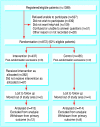Does home based medication review keep older people out of hospital? The HOMER randomised controlled trial
- PMID: 15665005
- PMCID: PMC548182
- DOI: 10.1136/bmj.38338.674583.AE
Does home based medication review keep older people out of hospital? The HOMER randomised controlled trial
Abstract
Objective: To determine whether home based medication review by pharmacists affects hospital readmission rates among older people.
Design: Randomised controlled trial.
Setting: Home based medication review after discharge from acute or community hospitals in Norfolk and Suffolk.
Participants: 872 patients aged over 80 recruited during an emergency admission (any cause) if returning to own home or warden controlled accommodation and taking two or more drugs daily on discharge.
Intervention: Two home visits by a pharmacist within two weeks and eight weeks of discharge to educate patients and carers about their drugs, remove out of date drugs, inform general practitioners of drug reactions or interactions, and inform the local pharmacist if a compliance aid is needed. Control arm received usual care.
Main outcome measure: Total emergency readmissions to hospital at six months. Secondary outcomes included death and quality of life measured with the EQ-5D.
Results: By six months 178 readmissions had occurred in the control group and 234 in the intervention group (rate ratio = 1.30, 95% confidence interval 1.07 to 1.58; P = 0.009, Poisson model). 49 deaths occurred in the intervention group compared with 63 in the control group (hazard ratio = 0.75, 0.52 to 1.10; P = 0.14). EQ-5D scores decreased (worsened) by a mean of 0.14 in the control group and 0.13 in the intervention group (difference = 0.01, -0.05 to 0.06; P = 0.84, t test).
Conclusions: The intervention was associated with a significantly higher rate of hospital admissions and did not significantly improve quality of life or reduce deaths. Further research is needed to explain this counterintuitive finding and to identify more effective methods of medication review.
Figures
References
-
- ASTRO-PUs and chapter STAR-PUs: 2001 revision. Leeds: Prescribing Support Unit, 2001.
-
- Office for National Statistics. UK Census 2001. www.statistics.gov.uk/census2001/pop2001/united_kingdom.asp (accessed 9 July 2004).
-
- Wright EC. Non-compliance—or how many aunts has Matilda? Lancet 1993;342: 909-13. - PubMed
Publication types
MeSH terms
LinkOut - more resources
Full Text Sources


